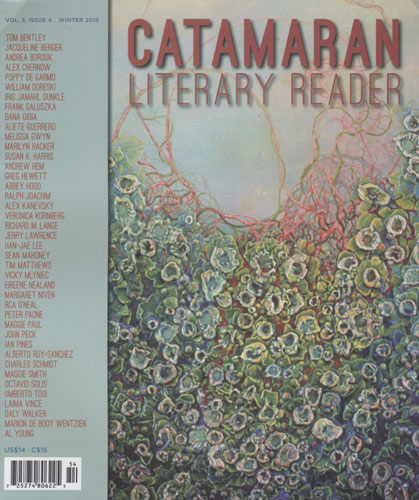Catamaran Literary Reader – Winter 2015
Melissa Gwyn’s oil painting on the cover of Catamaran Literary Reader hints at the 40 spectacular works inside by various artists. Gwyn’s creations are hard for me to describe, so I’ll let her do it: “Drawing upon the opulence and detail of Netherlandish painting and the sensual materiality of Abstract Expressionism, my work explores an ‘embarrassment of riches’ that is both visual and thematic.” Her description still leaves me hanging, but it doesn’t distract from the beauty and complexity of her paintings that appear to be flowers or buds and other times appear otherworldly.
Melissa Gwyn’s oil painting on the cover of Catamaran Literary Reader hints at the 40 spectacular works inside by various artists. Gwyn’s creations are hard for me to describe, so I’ll let her do it: “Drawing upon the opulence and detail of Netherlandish painting and the sensual materiality of Abstract Expressionism, my work explores an ‘embarrassment of riches’ that is both visual and thematic.” Her description still leaves me hanging, but it doesn’t distract from the beauty and complexity of her paintings that appear to be flowers or buds and other times appear otherworldly.
Another artist, Russian-born Alex Kanevsky, has oil on wood paintings, the majority displaying a human figure that’s almost invisible but slowly emerges. Ralph Joachim’s geometric abstractions pop from the pages, while Tim Matthews captures coastal scenes in photographs.
The main focus of the magazine, however, is literary readings, and Abbey Hood’s “Madame Mustache” is a highly original story. We meet the mustachioed Elanore, a gambling hooker, as she’s committing suicide: “The moon winked at her. Two stars waltzed around it and Elanore was glad she had killed her husband. . . . So vividly happy that she laughed and startled the dancing stars to stillness.” But this is no sad tale. What follows are fond recollections of Elanore.
Several essays deserve mention. Most striking is “Mother Ganga,” by Susan K. Harris. The title refers to the Ganges River, which in Hinduism is considered sacred and personified as a goddess. Harris, a Mark Twain Scholar, followed the journey described in Twain’s 1897 book Following the Equator. “The more I travelled, the more I realized that even though the India I encountered is a far cry from the India Twain experienced, the legacies of Twain’s India were still all around. One of them is pollution in the Ganges River.” Be warned: you don’t want to eat while reading descriptions of pollutants.
Here is Twain again in Tom Bentley’s “Tripping with Twain and Thompson.” Tripping, as in road trips. Thompson as in Hunter S. Thompson. Bentley hitchhikes, then travels in a succession of cars in order to follow the “call of the road.” But Bentley’s biggest tribute to Mark Twain is a “black-and-white rendering of him tattooed on my left bicep. The bicep isn’t much, but the tattoo is a dandy, down to the lit cigar.”
Among the nonfiction, readers will also find an interview this issue. I’m always put off when an interviewer takes as much copy as the interviewee. Maggie Paul’s interview of former California Poet Laureate Al Young comes close, but Young’s words shine through, beginning with his featured poem, “In the Realm of Film, A Lyric Form,” dedicated to the late screenwriter Gill Dennis:
A Patch of Blue, another film we loved,
you lived. You tried. There, Sidney Poitier
costars with your first wife. Blinded and shovedby pain, by struggle, you both soon collapse.
Young’s response to a question about public recognition: “The years I spent working in and out of Hollywood [ . . . ] taught me about the monster celebrity. I’ve never sought it. I know I’m well loved, onstage, on page, and off.” He took his writing workshop into Soledad State Prison, and states that for inmates “it’s their first opportunity to explore how they got locked up or locked down. [ . . . ] Inmates who read and think are no joke.” What about poems on the internet? “I don’t care what anyone says, the internet has been poetry-friendly. At one point, Google let it be known that one of the most frequent entries in its search engine was simply the word Poetry.”
Elsewhere in this issue, Laima Vince writes “Portrait of a Woman: Florentine 1459/60-1537” in short bursts. A sampling:
I am all the mad women
Locked in all the towers.I am the ancient one
Reborn from James Joyce’s
Irish stew.
Maggie Smith’s “London Plane” is about the plane tree. “Every year it sheds / its skin down to white bone. // I pick up a mottled cuff / and cup my wrist // to show my daughter / how to wear it.” And Alex Chernow, in “Kindergarden” begins her poem in this delightful way:
Roll your body in the dirt until your skin forgets its name,
plant seeds in your pores, rows of tomatoes in the soft crevices
of your body.
In summing up, Catamaran Literary Reader offers any art, poetry or prose lover a selection of works from the intense to the sublime, making it the perfect springtime read.
[www.catamaranliteraryreader.com]





